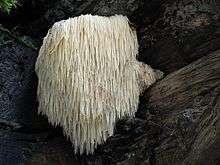Hericium erinaceus
| Hericium erinaceus | |
|---|---|
 | |
| Scientific classification | |
| Kingdom: | Fungi |
| Division: | Basidiomycota |
| Class: | Agaricomycetes |
| Order: | Russulales |
| Family: | Hericiaceae |
| Genus: | Hericium |
| Species: | H. erinaceus |
| Binomial name | |
| Hericium erinaceus | |
| Synonyms | |
| |
| Hericium erinaceus | |
|---|---|
|
| |
| teeth on hymenium | |
| no distinct cap | |
| lacks a stipe | |
| spore print is white | |
| ecology is parasitic | |
| edibility: choice | |
Hericium erinaceus (also called lion's mane mushroom, monkey head mushroom,[1] bearded tooth mushroom, satyr's beard, bearded hedgehog mushroom, pom pom mushroom, or bearded tooth fungus) is an edible and medicinal mushroom belonging to the tooth fungus group. Native to North America, Europe and Asia it can be identified by its long spines (greater than 1 cm length), its appearance on hardwoods and its tendency to grow a single clump of dangling spines.[2] Hericium erinaceus can be mistaken for other species of Hericium, all popular edibles, which grow across the same range. In the wild, these mushrooms are common during late summer and fall on hardwoods, particularly American beech.
Chemistry
Hericium erinaceus contains a number of polysaccharides, such as B-glucan, heteroglucans, and heteroxylans, as well as several cyathane derivative diterpenoids known as hericenones and erinacines.[2]
Research
As an extract or as a whole mushroom, H. erinaceus is under basic research for its potential biological properties.[2][3] While clinical research is in its early stages, such as for mild cognitive decline[4] or anxiety,[5] as of 2018, there is no conclusive evidence for health effects from consuming H. erinaceus.
Gallery
See also
References
- ↑ "Monkey Head Mushroom - GANOFARM". GANOFARM. 2017-04-10. Retrieved 2018-01-04.
- 1 2 3 Friedman, Mendel (2015). "Chemistry, Nutrition, and Health-Promoting Properties of Hericium erinaceus (Lion's Mane) Mushroom Fruiting Bodies and Mycelia and Their Bioactive Compounds". J. Agric. Food Chem. 63 (32): 7108–7123. doi:10.1021/acs.jafc.5b02914. PMID 26244378.
- ↑ Phan, CW; David, P; Naidu, M; Wong, KH; Sabaratnam, V (2015). "Therapeutic potential of culinary-medicinal mushrooms for the management of neurodegenerative diseases: Diversity, metabolite, and mechanism" (PDF). Critical Reviews in Biotechnology. 35 (3): 355–68. doi:10.3109/07388551.2014.887649. PMID 24654802.
- ↑ Mori, K (2009). "Improving effects of the mushroom Yamabushitake (Hericium erinaceus) on mild cognitive impairment: a double‐blind placebo‐controlled clinical trial". Phytotherapy Research: 367–372. PMID 18844328.
- ↑ Spelman, Kevin; Sutherland, Elizabeth; Bagade, Aravind (2017). "Neurological Activity of Lion's Mane (Hericium erinaceus)" (PDF). Journal of Restorative Medicine. 6 (1): 19–26. doi:10.14200/jrm.2017.6.0108.

